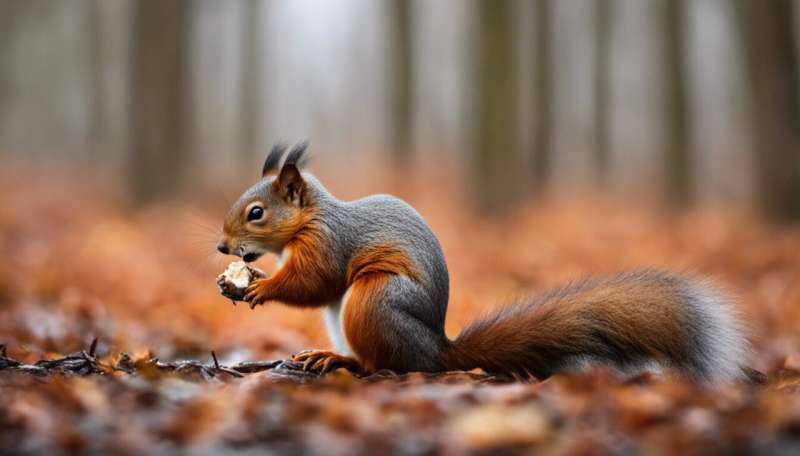Feeding British red squirrels may be changing their jaws

Feeding peanuts to red squirrels may be altering the development of their jaws.
A population of the endangered rodents living in Formby, Merseyside, have uniquely shaped lower jaws, possibly as the result of being fed softer foods. While the activity is now discouraged, the practice appears to have left a legacy in these squirrels, among the last to be living in mainland England.
While it is currently unclear if the changes in jaw structure are a result of evolution, or adaptations during its lifetime, the ability of researchers to track the changes is an indication of how isolated the squirrels are becoming.
Kim Chandler, a Ph.D. student at the University of York, is conducting research into how red squirrels are changing as a result of their diet.
“I don’t think these kinds of changes would have been observed if red squirrel populations were larger,” Kim explains. “Without genetic mixing between them, British populations have become very isolated from one another.”
“This means that populations in northern Scotland, Formby and elsewhere are effectively acting as their own evolutionary islands.”
Why are red squirrels declining?
Wind back the clock 150 years, and red squirrels would have lived in forests all over the country, as well as in outposts such as Jersey in the Channel Islands.
However, this all began to change in the late nineteenth century. Some of the earliest gray squirrels were introduced to Henbury, Cheshire in 1876, followed by further introductions in Bushey, Hertfordshire and Woburn, Bedfordshire over the following years.

These introductions were primarily for ornamental reasons, with North American gray squirrels released on private estates by wealthy landowners. As the rodents breed more quickly than their native counterparts, the gray squirrels soon began to spread beyond these boundaries of these estates and across the country.
They were assisted in their spread by squirrelpox, a viral disease carried benignly by gray squirrels but which is often lethal to red squirrels.
While the import and ownership of the invasive mammals was banned in the UK in 1937, it was already too late. Much of southeast and central England was already dominated by the invasive grays, and over the past 85 years they have continued to push north and west.
Today, red squirrels survive in the coniferous and broadleaf forests of Scotland, northern England and on islands such as the Isle of Wight and Anglesey. While there have been occasional translocations between them, each population is, for most intents and purposes, cut off from the rest.
How do red squirrel populations differ across the UK?
When populations are isolated from each other there is the opportunity for the separate groups to diverge as they respond to different resources and pressures in their respective environments.
As part of her Ph.D., Kim has been investigating if and how these changes are taking place by examining a collection of red squirrel skeletons collected from across Britain and held at the National Museum of Scotland.
“Museum collections are invaluable to my work, and it wouldn’t have been possible without it,” Kim says. “The collection at the National Museum of Scotland is continually being added to, which allows a clear trend to be observed over the previous few decades.”
Kim scanned the skeletons and used the digitized data to measure the shape of the cranium and lower jawbone, or mandible, from red squirrels from northern Scotland, northern England, Jersey and Formby over a period of time.
The different populations all had significantly different variation in the shape of their crania and mandible, with the bones of northern English and Scottish individuals significantly more robust than the Formby individuals.
The parts of the bone where muscles attached suggest that the Formby individuals had smaller masseter muscles, which are used to chew, than their more northern counterparts. Kim has linked this to the diet of the different populations.
“In Scotland there is a lot of pine, while northern England contains a mix of trees such as pine, hazelnut and oak,” Kim says. “These produce harder nuts and cones which require larger muscles to eat.”
“In Formby, the situation is very different. The feeding of peanuts to red squirrels in the past has given them softer foods that wouldn’t normally be found in their diet.”
One study suggests that in the 1990s as much as 56% of the Formby squirrels’ diet came from peanuts alone. Feeding the squirrels is now discouraged as it can affect the animals’ health, as well as being a potential way for disease to spread through this important population.
While the study shows that the average shape of their mandibles has changed in the past few decades, it isn’t enough to say whether or not it is evidence of evolution in action. The changes may instead be “plastic,” reflecting non-heritable adaptations to the available food sources, with more specimens needed to resolve this puzzle.
Kim is also hoping to answer other questions surrounding these adaptations in the rest of her Ph.D., by delving deeper into the process of how squirrels eat. She aims to examine the strength of bites in different populations, as well as investigating the difficulty in eating each of their food items.
Studies such as Kim’s will help scientists develop a greater understanding of these animals, feeding into projects that aim to conserve our native squirrels.
Feeding red squirrels peanuts may make natural diet a tough nut to crack
Citation:
Feeding British red squirrels may be changing their jaws (2022, October 18)
retrieved 18 October 2022
from https://phys.org/news/2022-10-british-red-squirrels-jaws.html
This document is subject to copyright. Apart from any fair dealing for the purpose of private study or research, no
part may be reproduced without the written permission. The content is provided for information purposes only.
For all the latest Science News Click Here
For the latest news and updates, follow us on Google News.

